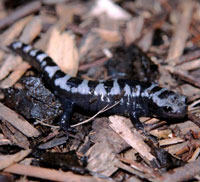Vol. 21 Issue 3, Fall 2016
By Kerry Bzdyk

Photo by Liam McGranahan
The Marbled Salamander (Abystoma opacum) is a stout-bodied, dark black salamander with bands of white (gray in the female) down its back and tail. It’s a beautiful salamander to see (if you can find it)! Adults are three to four inches long, with the female being slightly larger, and are found throughout the eastern United States. They prefer to live in or near damp woodlands and spend most of their time hidden in burrows or under logs, rocks and other debris. They often use abandoned burrows of other critters to stay out of sight below ground. They may emerge at night to feed on invertebrates and insects.
While salamanders might seem like a more appropriate subject for a springtime article, the Marbled Salamander has the unique trait of breeding in the fall. Mating occurs entirely on land and the female will lay 50 to 200 eggs under leaf litter in a dried-up pool or ditch. She will stay with the eggs and tend to them, keeping them moist, until the pool becomes inundated with water during a fall rain. The embryos will have already developed to an advanced stage within the egg, but will not hatch out until the rains come. The newly-hatched young will overwinter in the pool and continue to develop, completing their metamorphosis into adults in late spring of the following year. This gives the new ones a jump start on development over the springtime breeders. They reach full maturity in about 15 months.
This is a secretive and well-hidden species of salamander that is difcult to fnd, but striking in its appearance and unique in its reproductive timing. I’ll be thinking of them as the heavy rains of fall strip the last of the colorful leaves from the trees and help start the next generation of the Marbled Salamander.
Resources:
www.virginiaherpetologicalsociety.com/amphibians/ salamanders/marbled-salamander/marbled_salamander.php
www.marshall.edu/herp/Salamanders/marbled.htm

